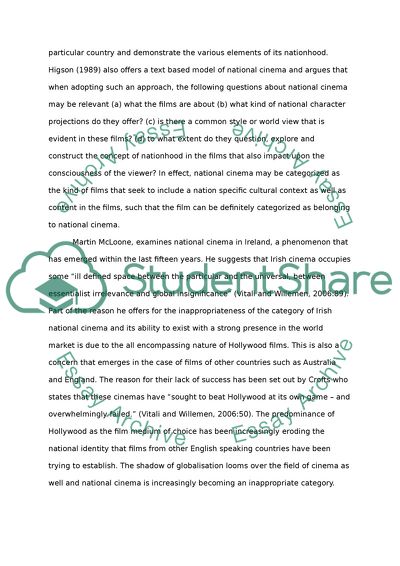Cite this document
(Concepts of National Cinema Literature review Example | Topics and Well Written Essays - 2000 words, n.d.)
Concepts of National Cinema Literature review Example | Topics and Well Written Essays - 2000 words. Retrieved from https://studentshare.org/visual-arts-film-studies/1732074-stephen-crofts-suggests-that-the-concept-of-national-cinema-is-no-longer-an-appropriate-critical-category-in-view-of-the-growing-lack-of-congruence-between-nations-and-nation-states-discuss-with-reference-to-relevant-literature-on-national-cinemas
Concepts of National Cinema Literature review Example | Topics and Well Written Essays - 2000 words. Retrieved from https://studentshare.org/visual-arts-film-studies/1732074-stephen-crofts-suggests-that-the-concept-of-national-cinema-is-no-longer-an-appropriate-critical-category-in-view-of-the-growing-lack-of-congruence-between-nations-and-nation-states-discuss-with-reference-to-relevant-literature-on-national-cinemas
(Concepts of National Cinema Literature Review Example | Topics and Well Written Essays - 2000 Words)
Concepts of National Cinema Literature Review Example | Topics and Well Written Essays - 2000 Words. https://studentshare.org/visual-arts-film-studies/1732074-stephen-crofts-suggests-that-the-concept-of-national-cinema-is-no-longer-an-appropriate-critical-category-in-view-of-the-growing-lack-of-congruence-between-nations-and-nation-states-discuss-with-reference-to-relevant-literature-on-national-cinemas.
Concepts of National Cinema Literature Review Example | Topics and Well Written Essays - 2000 Words. https://studentshare.org/visual-arts-film-studies/1732074-stephen-crofts-suggests-that-the-concept-of-national-cinema-is-no-longer-an-appropriate-critical-category-in-view-of-the-growing-lack-of-congruence-between-nations-and-nation-states-discuss-with-reference-to-relevant-literature-on-national-cinemas.
“Concepts of National Cinema Literature Review Example | Topics and Well Written Essays - 2000 Words”. https://studentshare.org/visual-arts-film-studies/1732074-stephen-crofts-suggests-that-the-concept-of-national-cinema-is-no-longer-an-appropriate-critical-category-in-view-of-the-growing-lack-of-congruence-between-nations-and-nation-states-discuss-with-reference-to-relevant-literature-on-national-cinemas.


